The air and sea attack known as Operation Hailstone occurred Feb. 17-18, 1944, in the Micronesian islands of Truk Lagoon. The islands, which lie in Chuuk State, had been occupied by Japan since World War I and were an anchorage for the Imperial Japanese Navy. During World War II, Japan covered a large area in the Pacific, but Truk was their main stronghold. For the American forces to move forward, the area needed to be neutralized. The U.S. Navy destroyed more than 40 ships and 250 planes during Operation Hailstone, making the lagoon one of the largest shipwreck graveyards.
Today the Federated States of Micronesia haven’t changed much visually. The Chuuk atoll is lush with towering mountains, the air smells of flowers, and banana trees are everywhere. Fishing, farming and tourism drive the economy. There are a few hotels, and liveaboard boats attract visitors from all over the world to dive warships, merchant ships, minesweepers, tankers, destroyers, gunboats, a submarine and several types of aircraft. It’s as if time stood still.
A common misconception about Truk Lagoon is that it’s only for technical divers. Many of the wrecks are in recreational range at just 30 to 100 feet. One of the best parts of diving here is that shallower depths can allow for longer bottom times, giving you more time to explore the wrecks. The deeper wrecks, in the 150- to 200-foot range, are equally interesting. There is something here for every experience level.

Descending to the wrecks, the violence that sent these ships to their final resting place becomes evident. After all these years the wrecks appear to be lying serene on the bottom, but a closer look reveals torpedo blasts and mangled steel. Now covered in colorful coral, the ships are full of marine life. Inside cargo holds you’ll find planes, trucks, gas masks, tractors, ammuntion, torpedoes, aviation fuel, medicine, mines, saké, bombs and bones. The lagoon can have great visibility, and in those conditions it’s easy to see a lot of the wreck, including bow and stern guns, pom-poms (anti-aircraft guns), battle tanks and bridges with intact telegraphs. If you’re more adventurous you can explore stunning engine rooms.
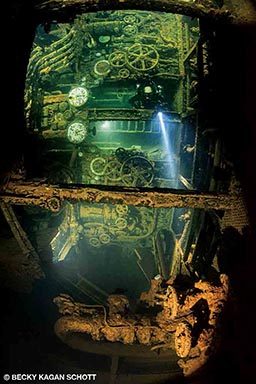
The amount of destruction that occurred over just two days is astounding, and many of the wrecks are near each other. A diver could spend weeks diving on just one of the wrecks; so many of them in such close proximity makes this a first-class wreck-diving destination. Some of the most popular wrecks for recreational divers include the Fujikawa Maru, Hoki Maru, Nippo Maru and Sankisan Maru; for technical divers, the deeper wrecks include San Francisco Maru, Aikoku Maru and Oite.
One of the premier wrecks to dive due to its shallow depth (30 to 120 feet) and abundance of marine life, the Fujikawa Maru is covered in colorful soft corals, anemones and all types of fish — from schooling fish to sharks. Sunk by torpedo fire and bombing, the 433-foot-long armed aircraft ferry had been a cargo ship (maru signifies a merchant vessel). The bow gun, once used for destruction, is now heavily encrusted with marine growth, and the builder’s plaque on the back is still legible. Dropping into the first cargo hold you’ll find barrels of fuel and artillery shells. Other cargo holds have several Zero plane fuselages and a collection of saké bottles. Divers can also explore the galley and baths with sinks lining the wall. Certain areas, including the bridge and parts of the engine room, have unfortunately started to collapse due to previous dynamite fishing on the wreck. The machine shop is intact, including tool benches with vises. Storage rooms are stocked with supplies, still organized on shelves as they were 74 years ago. Down a stairway, divers can see a telephone booth with a phone on the wall, gauges, a telegraph and a compressor.
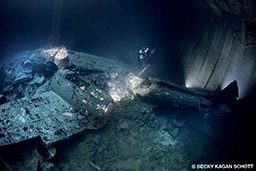
The Nippo Maru is my personal favorite. Its sister ship, the Momokawa Maru, also sank but lies on its port side. The Nippo starts at 90 feet, the deck is at 120 feet, and the maximum depth is the seafloor at 155 feet. The 354-foot-long ship transported fresh water, firewood, munitions and vehicles during the war. The wreck is upright and has a stunning wheelhouse with intact telegraphs and helm. Peering out from the wheelhouse, a Mitsubishi Type 95 Ha-Go tank rests on the port-side deck at 125 feet. The Nippo has cargo holds with gas masks and ammunition, and the bow is quite picturesque. Looking inside the engine room, divers can see the stairs corkscrewing down; at the bottom is a beautiful set of gauges with the Japanese text still visible.
The Sankisan Maru is very accessible — its bow sits just 3 feet below the surface. The stern was blown off and sits in deeper water, but the bow is intact. From above water, visitors can see a great deal of the ship; divers will be amazed at the marine life as they descend past the masts covered in a plethora of soft coral. Trucks along the deck at 50 feet are covered in coral growth so that all you can see are the wheels. Boxes of ammunition and medicine bottles litter the bottom inside the cargo holds, while intact trucks and engines rest in another hold.
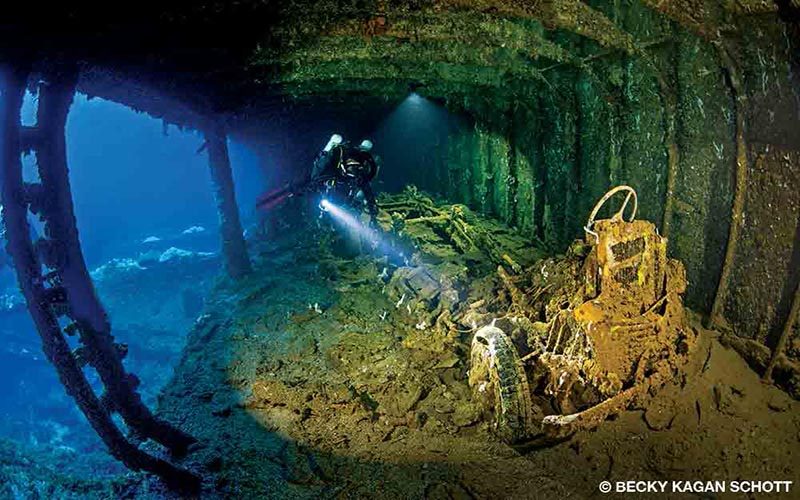
The 461-foot-long passenger liner Rio de Janeiro Maru carried nearly 1,300 passengers and crew in the 1930s. During the war it first became a submarine depot ship (sub tender) and then a transport ship in 1943. Struck with one or two 1,000-pound bombs during the first day of the attack, the ship sank the following day 450 yards from shore. Resting on its starboard side between 30 and 110 feet, the wreck has no shortage of things to see. On the stern are a large gun and the dual props; if divers look closely at the stern they can still see the name of the ship. The engine room is picturesque with wheels, a clock and inclinometer, and the cargo holds have crates of beer and large wheel turrets. The bow gun is twisted almost underneath it. Divers can make a safety stop near the wreck and may even see a few sharks pass by.
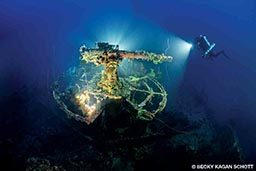
Known as the “million-dollar wreck,” the San Francisco Maru was a big loss for the Japanese. The wreck sits upright on its keel, mostly intact except for damage from the six 500-pound bombs that sank it. Resting in 140 to 210 feet of water, the San Francisco is one of the most popular deep dives in the lagoon. Each cargo hold has something interesting to see: One is full of hemispherical mines, bombs and detonators; another has two large trucks. Coral encrustation is all that holds many of the mines in place, which can be a little unnerving.
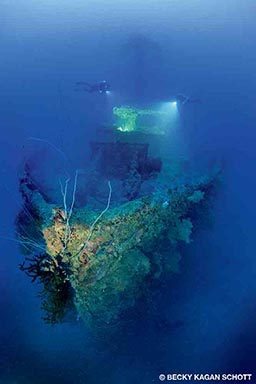
Several picturesque three-man tanks are on the deck. One of the best parts of the dive is the iconic bow gun, which is now covered in colorful coral and frozen in time. The visibility is typically good, so it’s nice to swim off the bow and get a wider perspective of the bow gun with the mast behind it.
The destroyer Oite was escorting the light cruiser Agano when the Agano was struck by a torpedo and sank. Survivors were brought onto the Oite, but it was also hit by a torpedo and blown completely in half. The ship was carrying 148 people plus the Agano survivors, and only 20 people survived the attack. It now rests at 170 to 205 feet with the bow upside down and the stern upright. Human remains can be seen both outside and inside the wreck along with artifacts such as china, vinyl records and two anti-aircraft guns on the stern. The Oite is further away than most wrecks, so plan to dive it when the weather is nice.
Most divers have Truk Lagoon at the top of their bucket list because the islands, people, history, stories and shipwrecks are truly moving. Some people say it is a once-in-a-lifetime dive destination, but with so many large wrecks and so much to discover on each of them, it’s a destination divers could visit several times and still not see everything. It’s humbling to see such massive ships sitting on the bottom and bombs that would have been used in war at rest in cargo holds. The amount of destruction that occurred during Operation Hailstone is hard to describe. No matter how many history books you read, true perspective is elusive until you see it for yourself.
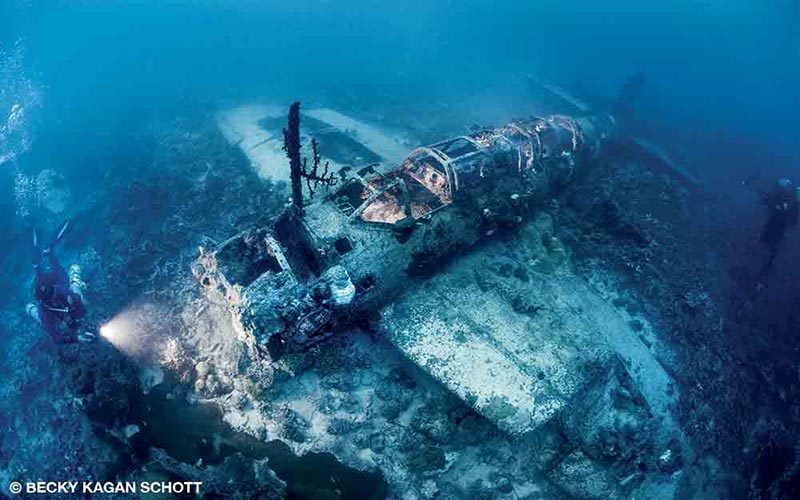
How to Dive It

as does the Mitsubishi G4M “Betty” bomber and many Zero fighters.
Conditions: Divers can visit Truk Lagoon year-round. The water temperatures typically are in the 80s°F, and visibility ranges from 50 to 100 feet.
Getting there: Traveling to Truk isn’t easy, but it’s worth it. United Airlines has the best and sometimes only flight options. I suggest going through Guam to Truk and avoiding the island hopper that stops six times from Hawaii to Truk.
Dive guides: The dive guides here are some of the most skilled I’ve ever dived with. They know where to find each wreck, sometimes by just looking at features on land. Stick with them, and they’ll give you the best tour of each wreck, ensuring that you don’t miss anything. They’ll guide you inside and show you planes, engine rooms, trucks, telegraphs and details that would take many dives to discover on your own.
Explore More
| © Alert Diver — Q2 2018 |